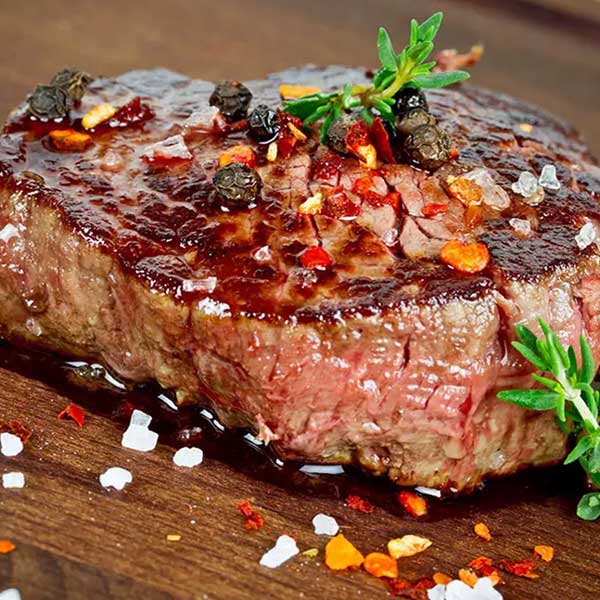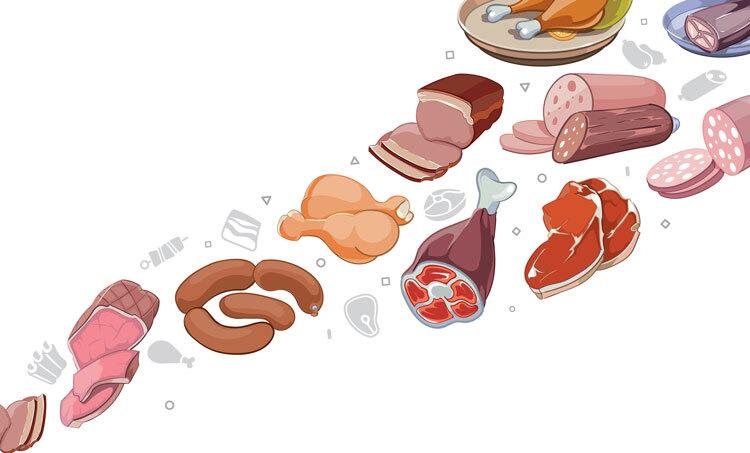This comprehensive guide aims to provide readers with helpful advice to choose the best meat for any dish they want to make. With so many options available from beef to seafood to plant-based meat alternatives, it can be challenging to select the optimal meat that will make the recipe shine.
The goal is to outline the unique flavours, textures, cooking methods, and typical uses for the most common types of meat. This will equip home cooks with knowledge to complement ingredients, achieve the desired results, and bring their culinary creations to life. Whether you’re cooking an elaborate dinner party menu or a simple weeknight pasta, having savvy insights on meats can level up your skills in the kitchen.
By the end of this guide, you’ll have a solid understanding of how to match meats to preparation techniques and recipes to create successful, tasty meals. With the right know-how, you can avoid bland or overcooked dishes and instead turn out perfect proteins and showstopping entrées. Let’s get started exploring the array of meat choices available and how to pick the prime cut for any occasion!
Beef
Beef is a versatile meat that comes from cows. It has a rich, meaty flavour and can vary in texture and tenderness depending on the cut.
Types of Beef Cuts
The following are the main types of beef cuts:
- Steaks – Steaks are cuts from the loin and rib of the cow. They contain less connective tissue, so they are more tender. Popular steak cuts include ribeye, New York strip, filet mignon, and T-bone. Steaks are best cooked quickly over high heat to sear and cook to desired doneness.
- Roasts – Roasts are larger cuts from the round, chuck, rib, and loin. They contain more connective tissue and are ideal for slow cooking methods like braising, roasting, or stewing to break down the connective tissue. Common roasts include chuck roast, rib roast, rump roast, and sirloin tip roast.
- Ground Beef– Ground beef is made by grinding up trimmings and smaller pieces of beef. The fat percentage can range from 5% (very lean) to 30% (high fat). Ground beef is extremely versatile and can be used to make burgers, meatballs, meatloaf, chili, tacos, and more.
The wide variety of beef cuts allows cooks to choose the right cut for any dish, based on price, preparation method, and desired texture. Knowing the differences between the types of beef cuts is helpful for selecting and cooking beef properly.
Pork
Pork comes from pigs and has become more lean and tender over the years due to changes in how pigs are raised and fed. There are many delicious cuts of pork to choose from when planning a meal.
Pork Chops
Pork chops come from the loin or rib area of the pig. Bone-in pork chops have more flavour because the bone imparts extra taste, but boneless chops are easier to eat. Thick-cut chops are juicy and tender when cooked with a quick sear or grill. Thin chops are ideal for breading and frying or sautéing.
Pork Tenderloin
The pork tenderloin is an oblong, cylindrical cut that is very lean and tender. It can be cut into medallions and sautéed or pounded thin for breading. Left whole, it is delicious rubbed with spices and roasted in the oven.
Pork Shoulder
Pork shoulder can be cured and smoked to make ham or roasted low and slow to produce succulent pulled pork. The high fat content keeps pork shoulder moist during cooking. pork shoulder can also be cut into cubes for stews or ground for sausage.
Pork Belly
Pork belly is responsible for bacon and has a high fat content with streaks of lean meat. It can be roasted or braised for rich flavour. Pork belly is often used in Asian dishes.
Pork Ribs
Pork ribs come from the belly or loin area. Baby back ribs are shorter ribs from the loin that cook more quickly. Spareribs are longer ribs from the belly that require low and slow roasting. Ribs can be cooked with dry rubs, sauces, or marinades for finger-licking barbecue.
Chicken
Chicken can be a great option for many dishes thanks to its versatility and mild flavour. When choosing chicken, one of the first decisions is whether to use white or dark meat.
White Meat
Chicken breast is the leanest part of the chicken and the quintessential white meat. Boneless, skinless chicken breasts are extremely low in fat and high in protein. The mild flavour and tender texture make chicken breast a go-to for many classic dishes like chicken entrees, sandwiches, salads, and more. Chicken breast is easy to season and pairs well with a wide range of flavours. It cooks quickly, especially when pounded thin. Just take care not to overcook chicken breast to keep it juicy and flavourful.
Dark Meat
Chicken thighs and legs have more fat, collagen, and flavour than white meat. The extra fat keeps dark meat juicy and tender even with longer cooking times. The rich flavour gives more chicken taste that stands up to bold seasonings and spices. Chicken thighs are a favourite for stews, curries, and braises. Chicken legs are often roasted whole or used in soup. The skin gets beautifully crisp when roasted. Some chefs even grind dark meat for burgers to enhance the chicken flavour. Both white and dark meat have their advantages, so consider what texture and flavour profile will work best.
Fish and Seafood
Fish and seafood offer a light and healthy protein option that is lower in saturated fat compared to other meats. When choosing fish for your dish, consider if you want a lean fish or a fatty fish.
Lean fish like cod, haddock, tilapia, and flounder provide plenty of protein while being relatively low in fat. They have a mild, delicate flavour that works well in a variety of dishes from fish tacos to fish and chips. Their mild taste also makes them a good choice for ceviches, oven bakes, and other preparations where you want the fresh flavour of the fish to shine through.
Fatty fish like salmon, mackerel, sardines, and trout have more fat, but it’s primarily heart-healthy omega-3 fatty acids. The higher fat content makes these fish more moist and richly flavoured. Salmon is excellent grilled or baked, while the stronger taste of mackerel and sardines pairs well with bold seasonings and sauces. The fatty texture of these fish also makes them ideal for smoking, as the fat helps them stay moist.
When deciding between a lean whitefish or a fattier oily fish, consider the flavour profile you want and how you plan to cook it. Delicate whitefish are best for ceviches, hearty oily fish work well grilled or smoked, and all types of fish can be baked, broiled, or added to chowders and tacos. Getting a mix of lean and fatty fish in your diet can help you reap all the nutritional benefits that seafood has to offer.
Lamb
Lamb offers a delicious, mild and slightly sweet flavour that can be used in a variety of dishes. When choosing lamb, consider what cut and preparation method best suits your recipe.
Cuts for Grilling
For grilling, choose cuts from the loin or rib area which tend to be more tender and cook quickly over high heat. Good grilling choices include:
- Lamb loin chops – Have a T-bone shape with both loin and tenderloin meat. Best cooked hot and fast to medium or medium-rare doneness.
- Lamb rib chops – Cut from the rib area with rib bone attached. Can be cooked slightly slower to medium doneness. Has good marbling for flavour.
- Butterflied leg of lamb – The whole leg is boned, opened up and pounded thin. Quickly grills to medium rare while retaining moisture.
- Ground lamb patties – Form ground lamb into patties and grill like burgers to medium doneness. Easy to flavour with spices and herbs.
Cuts for Braising
For braised lamb dishes with fork-tender results, choose cuts from the shoulder, leg, or shank which have more connective tissue. Good braising choices include:
- Lamb shanks – Braising breaks down the collagen for fall-off-the-bone texture. Pair with tomato, wine or root vegetable braises.
- Lamb shoulder chops – Braise chops until meat easily falls off the bone. Use in stews or chop and serve over polenta.
- Boneless leg of lamb – Braise whole, half or cubed pieces. Shred for tacos, slice for entrees, or use in cottage pie.
- Lamb neck slices – An affordable cut good for stews. Braise until meltingly tender.
When braising lamb, cooking low and slow in liquid builds deep flavour while tenderizing the meat. The rich, savoury flavour pairs beautifully with aromatic vegetables, herbs and spices.
Veal
Veal comes from young calves that are typically under 4 months old. It has a mild and delicate flavour compared to beef from older cattle. The meat is pale pink in colour.
Veal goes well in delicate dishes that would be overpowered by the stronger flavour of beef. It can be used in recipes like veal scaloppini, veal Marsala, veal Parmesan, or veal osso bucco. The tender texture of veal also makes it ideal for preparations like veal cutlets.
Some key advantages of cooking with veal include:
- Smooth, tender texture – Veal is very low in connective tissue so it has a refined texture great for quick cooking.
- Mild flavour – The subtle flavour of veal nicely absorbs other ingredients like herbs, spices, sauces, and wine.
- Lean yet moist – Veal is lower in fat than beef but still juicy and flavourful.
- Easy to prepare – Veal chops, cutlets, and scallops are quick-cooking and easy to prepare in a pan, grill or oven.
- Versatile ingredient – Veal pairs well with numerous flavours from Italian, French, German and other cuisines.
The delicacy of veal makes it unsuitable for stews, barbecues, or other dishes requiring longer cooking times. For the best results, veal should be cooked gently using moist heat cooking methods.
Game Meats
Game meats like venison and bison offer a flavourful, nutrient-dense alternative to traditional meats like beef and chicken. Game meats come from animals that are hunted in the wild such as deer, elk, boar, rabbit, and birds like pheasant, quail, and duck.
- Venison comes from deer and is an extremely lean red meat. It has a rich, meaty flavour that is similar to beef but less fatty. Venison contains high levels of protein and iron while being lower in calories and cholesterol than beef. It works very well in stews, chili, burgers, meatloaf, steaks, or ground in a Bolognese sauce.
- Bison is another popular game meat that comes from American buffalo. It has a sweet, dense flavour and lean texture. Bison is high in protein, iron, and B vitamins while being lower in fat and calories than beef. It can replace ground beef in any recipe but also works well grilled as steaks or burgers. Bison has a tendency to dry out so slow-cooking stews or braises are recommended.
Other game options include boar, rabbit, duck, goose and pheasant. Wild boar has a distinct, wine-infused flavour from the animal’s diet of roots and plants. Rabbit is an extremely lean white meat with a delicate, mildly sweet flavour. Duck and goose are fattier dark meats with rich, full flavours perfect for braising. Pheasant has a delicate flavour that is similar to chicken but more refined.
Game meats offer a nice change of pace for more adventurous eaters looking to try something new and different. Just be sure to cook them properly and not overcook, as they tend to be leaner than domesticated meats.
Meat Substitutes
For those looking to reduce meat consumption or follow a vegetarian or vegan diet, there are many tasty and nutritious meat substitute options available. Meat substitutes typically mimic the texture, flavour, and nutritional profile of meat, but are made from plant-based ingredients.
- Tofu is one of the most widely used meat substitutes. It is made from soybeans and comes in a variety of textures from silken to extra firm. Tofu takes on the flavours of sauces and seasonings added to it. It can be scrambled like eggs, diced and sauteed, or baked and marinated. Tofu provides protein, calcium, iron and other nutrients.
- Seitan is made from wheat gluten and has a chewy, meat-like texture. It can be flavoured in a multitude of ways and offers a substantial protein source for vegetarian and vegan diets. Seitan can be used in stews, stir-fries, skewers, sandwiches and more.
- Tempeh is made from fermented soybeans and has a firm texture and nutty, mushroom-like flavour. It serves as a versatile protein substitute and can be crumbled, sliced, baked, steamed or fried. Tempeh contains probiotics from the fermentation process.
There are also meat substitutes made from pea protein, wheat protein, as well as mushrooms and jackfruit. New plant-based meat substitutes aim to replicate the taste and texture of real meat as closely as possible using ingredients like pea protein, soy protein, beet juice and coconut oil. These work well in dishes like burgers, tacos, chili and pasta sauce.
With so many options now available, meat substitutes can be easily incorporated into a wide variety of recipes. They offer an easy way for all diets to get satisfying protein and nutrients from plants rather than animals.
Choosing Meat for Specific Dishes
When choosing what type of meat to use for a dish, it’s important to consider the cooking method and what flavours you want to highlight. Here are some tips:
Braising and Stewing
Tougher cuts of meat that have more connective tissue are ideal for braises and stews. These long, slow cooking methods help break down the connective tissue and make the meat fall-apart tender. Good options include:
- Beef chuck, brisket, or short ribs
- Pork shoulder or pork belly
- Lamb shoulder or shank
Grilling and Broiling
Leaner, tender cuts of meat work best for quick, hot cooking methods like grilling and broiling. The high heat helps create a nice sear while keeping the inside juicy. Recommended cuts include:
- Beef sirloin, tenderloin, or strip steaks
- Pork chops or tenderloin
- Boneless chicken breasts or thighs
- Fish fillets like salmon, halibut, tuna, or swordfish
Roasting
For roasted meats, choose uniform cuts that will cook evenly. Opt for more flavourful meats since the roast won’t be simmering in a sauce. Good choices are:
- Beef rib roast, tenderloin, or sirloin tip
- Bone-in chicken pieces or a whole chicken
- Pork loin or crown roast
- Leg of lamb
Sautéing
Thin, tender cuts do well sautéed in a pan. Make sure to slice across the grain if using tougher meats. Good sauté options include:
- Thinly sliced steak, pork chops, or chicken breasts
- Shrimp, scallops, fish fillets
- Strips or cubes of lamb or beef sirloin
So, in summary, match the cut of meat to both the cooking method and the flavour profile you want. With so many options to choose from, you’re sure to find the right meat for any dish.







